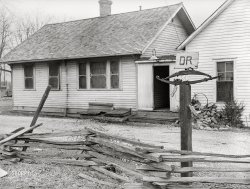
MAY CONTAIN NUTS

Search Shorpy
SHORPY ART

Framed or unframed, desk size to sofa size, printed by us in Arizona and Alabama since 2007. Explore now.
Join and Share
Ad-Free Shorpy
Shorpy is funded by you. Patreon contributors get an ad-free experience.
Learn more.

Recent comments
- Alas, hidden from view
- Exclusive pump
- Details, Details
- What's that building to the left of the tower?
- Coal Barges
- Bromo-Seltzer
- Inner harbor
- The Basin
- What a headache!
- Giant stepladder?
- Baldwin 62303
- Baldwin VO-1000
- Cold
- No expense spared
- Tough Guys
- Lost in Toyland
- And without gloves
- If I were a blindfolded time traveler
- Smoke Consumer Also Cooks
- Oh that stove!
- Possibly still there?
- What?!?
- $100 Reward
- Freeze Frame
- Texas Flyer wanted
- Just a Year Too Soon
- WWII -- Replacing men with women at the railroad crossing.
- Yes, Icing
- You kids drive me nuts!
- NOT An Easy Job
Member Photos
The Shorpy
Print Emporium
Print Emporium
Search Shorpy
Search results -- 30 results per page
- Two Moons: 1888
- Washington, D.C., 1888. "Two Moons and American Horse, Cheyenne chiefs." Veterans of the Battle of the Little Big ... education for his people, including the notorious Carlisle Indian Industrial School.
Purple Heart? The gent is possibly sporting a ... Posted by Dave - 07/06/2022 - 10:32am -
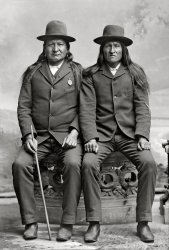
- Texas Bodega: 1939
- ... The Argo corn starch maiden has been diminished and her American Indian identity downplayed. The Quaker, looking a bit smug, no longer greets us ... Posted by Dave - 01/16/2022 - 7:23pm -
![Texas Bodega: 1939 March 1939. "Small Mexican grocery store. San Antonio, Texas." Medium format acetate negative by Russell Lee for the Farm Security Administration. View full size.
Old Anheuser-Busch productI love looking at pics of old stores like this. I noted the A-B Table Syrup 4th shelf all the way to the right. I wonder when that item stopped being marketed.
[It was advertised in newspapers as late as 1945. - Dave]
SaxetAs every Texan knows, that's Texas spelled backwards. Best known today as the name of a never-ending gun show, and don't you dare call it "dainty". (I mean, personally I don't mind if you call it dainty, but other people might.)
Staples, not convenience foods, but noteworthy also the number of kerosene lamp chimneys. Granted, these items are easily broken, but San Antonio was and is a major city, and major cities had electricity long before 1939. An ill-served non-electrified enclave? Emergency lighting? Or just dead stock?
Let me have one of those cans of Chuck Wagon… a ballpoint pen, and one of those Kiltie Pops there, a pint of Old Harper, a couple of flashlight batteries and some beef jerky.
CornucopiaI'll have one of everything, por favor.
The more things change --What strikes me most about this photo is how little many brands and labels have changed over 82+ years!
Don't make me come over that counterI don't see price stickers on anything and remember the days when a cashier simply knew the price of most items. Customers would let them know if a price seemed out of line. On each vertical divider is a paper clip, each holding a different type of paper. One looks like a receipt. Does anyone know what those were for?
I give this cashier a B+ on stacking merchandise. But it offends my anal retentive sensibilities that the cans of PET Milk are not all facing forward, and the one can of K C 5 Baking Powder turned backwards is driving me crazy. Don't even get me started on the salt.
So cows are now pets?The cans of milk in the upper right corner of the shelf might make one think so.
IconsAunt Jemima's makeovers didn't take, so she was retired (image, name, and brand) in 2021. The Argo corn starch maiden has been diminished and her American Indian identity downplayed. The Quaker, looking a bit smug, no longer greets us with open arms. Brer Rabbit has been pushing syrup since 1907, but competitors Teddy and Mary Jane have given up. The Pet milk cow continues to peek out of her can. Our Mother is enjoying retirement, though she worries about what Texas Girl gets up to.
Is this store in Mexico or Texas, or is this before the Alamo?How is this a "Mexican grocery store?" The products are US products and the labeling is in English.
[It's in the Mexican section of San Antonio and is owned by a Mexican. - Dave]
Responding to a comment. Yes, the clerk and the clients may know all the prices, but we wouldn't put up with such a limited selection. We may have too many choices now, but I'm not ready to go back to beans, rice and white bread.
Couldn't find out why the name "Pet." Wikipedia and the Pet website provided no explanation.
[In 1923, the Helvetia Milk Condensing Company was renamed the Pet Milk Company after its signature product, "Our Pet" Evaporated Cream. - Dave]
Mr. Monk would not approveThere are many things in this photo that bother the OCD in me.
What would be... inside those small tied up packages on the bottom shelf?
Post Toasties Corn Flakes...in Reverse!On the top shelf, it appears the Corn Flakes boxes were turned around, with the back showing the awesome crafts and giveaways, being promoted by Walt Disney!
Product DesignMy eye was immediately drawn to the glass jars, each shaped beautifully in their own way.
Texas GirlWhat a fantastic catalogue of extraordinary words contained within the array of products on these shelves: Chuck Wagon, Ole Reliable, Saxet, Our Mother’s, Argo, Aunt Jemima, Popeye the Sailor, Apex, Mary Jane, Brer Rabbit, Jefferson Island, Excelo, Teddy Bear, Lamo Lye, Rinso, Lux. My favorite is Texas Girl.
Anything and everything in a canExcept lettuce.
If you pleaseI will have a Derby Sugar Shaker Jar and one of those unmarked brown paper packages tied up with string. Then I will offer to, free of charge, organize all of the cans and boxes so that nothing is upside down. Drives me crazy. Right the Rinso already!
Calling all artistsThis is just *screaming* for colorizing. Any takers?
Almost eponymousIt was my desire to devise a clever jape over the possibility that Mr. Russell Lee had purchased a can of R. Lee's Special Sauer Kraut at this emporium, but alas, after downloading the full-size tiff from the LOC, I found my hope dashed by a vagrant reflection.
A.R. Lee's Special Sauer KrautFor TTerrace, here is an actual label, that would have been on the can.
Sure enough, one had sold on eBay!
Must be a Texas thing.Anybody know what "Kiltie Pops" are? It seems that the box has been up there for awhile.
Quite a selectionLots of beans, lots of crackers. What surprised me is the mentholated tobacco. Kool's ancestor?
A-B SyrupThe photo was taken some five years after Prohibition ended. Perhaps it was one of the products made by the brewer to get by until the Volstead Act was abolished.
That product might have been on the shelf for five years?
[A-B Syrup was being sold well into the 1940s. Branding notwithstanding, it was a product of the Southern Syrup Co. of New Orleans. - Dave]
Dippin' SnuffSeeing those tins of Garrett's Snuff on the shelf in front of the match boxes reminds me of an old fellow who ran a small engine repair shop in my East Texas hometown. He fixed lawnmowers and tillers and chainsaws and such out of a barn behind his house on the outskirts of town, just a couple miles from the Red River bottoms north of Texarkana.
I cannot recall the gentleman's name, but he had to be nearing 80 years in the 1970s. He dipped that Garrett snuff and would stand at his workbench while sharpening a mower blade and kept a Coke bottle at his feet and would spit a long string of brown tobacco juice right into the bottle without any spittle running down the outside of it. Every time. He never missed. It was pure poetry. He'd stop mid-sentence and "ssspt" into the bottle and resume his soliloquy without missing a beat.
He kept little screws and washers and nuts and carburetor parts in those snuff tins up on a shelf above his workbench. I don't think I've seen one of those snuff tins since, but this photo took me right back there in that old man's barn.
Goober Pea
(The Gallery, Russell Lee, Stores & Markets)](https://www.shorpy.com/files/images/SHORPY-8b21314a.thumbnail.jpg)
- Navajo Mask (Colorized): 1905
- My color version of a Navajo Indian wearing a mask of Haschebaad. The original photo was taken in 1905 by Edward Curtis and is part of his book The North American Indian Volume 1.
(Colorized Photos) ... Posted by triryguy - 01/22/2019 - 4:04pm -
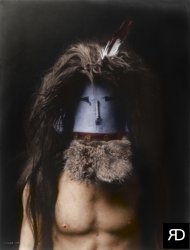
- Washington Flour: 1926
- ... though, is its self-rising flour. Washington also makes Indian Head corn meal, which is the best.
... and railroad to the K street side of the mill. In the American milling industry, the Wilkins Rogers firm counts itself at the "end of ... Posted by Dave - 08/05/2012 - 5:31pm -
![Washington Flour: 1926 Washington, D.C., circa 1926. "Wilkins-Rogers Milling Co., exterior, 3261 Water Street." The Washington Flour mill on K Street, formerly Water Street, in Georgetown. The Washington Flour brand had a retail presence at least into the late 1960s. National Photo Company Collection glass negative. View full size.
The buildingsIt's so great that the two buildings in the picture have survived, and it seems with very few exterior changes. As you travel in the Google videos it's plain to see the brick work and architecture is basically the same as when the picture was taken. I love those Google shots.
[Actually both buildings are only about three-quarters their original size; their river-facing sides were lopped off by the Whitehurst Freeway. They started out rectangular but ended up as trapezoids. - Dave]
View Larger Map
Wilkins-RogersI'm not sure when W-R stopped milling in D.C., but the company still has mills in Ellicott City, on a site that has had a mill since the Ellicott brothers went into business there in 1772. The only product that still bears the Washington brand name, though, is its self-rising flour. Washington also makes Indian Head corn meal, which is the best.
http://www.wrmills.com/index.html
Cadillac PickupSomebody give us the dope on that odd truck in the lower right is it a Caddy or what?
[It's a pickup truck that belongs to the Washington Cadillac Co. - Dave]
Check out the boxcars...The front two cars are from the Baltimore & Ohio and Pennsylvania railroads.
I always went for the RR's in Monopoly, it's fun to see the real deal!
Bulb changingDoes anyone else wonder how they changed the bulbs in those sign lamps perched six stories up? In those days bulbs had to be changed often and they didn't have bucket trucks back then.
A Georgetown fixture for yearsIf I'm not mistaken, this mill building was a fixture of the Georgetown waterfront area until a few years ago. Our grade school class visited there once. Those sun-drenched bricks and railroad tracks were later shadowed by an elevated expressway, and that blank facade could be seen close to the roadway. The bricks can still be seen peeking out from underneath the asphalt in places.
[These buildings still stand next to the Whitehurst Freeway, where the expressway (built in 1949) crosses Potomac Street. They're part of an office complex at 1000 Potomac that sold for $50 million in 2007. - Dave]
View Larger Map
View Larger Map
Objectionable OdorsI seem to recall that in the 70's there was a rendering plant on Water Street that made quite a stink, and that from the freeway, you could see a sign painted on that flour mill that said "The objectionable odors that you may notice in this area do not originate from this plant."
A small correctionThe street that runs by the old flour mill and later beneath the Whitehurst freeway is K Street N.W. I used to police this area for some ten years while with the M.P.D.C. 1959-1969.
[The street than ran by the flour mill was Water Street, which became K Street after the Georgetown street renaming of 1895. People evidently continued to call that stretch Water Street for years afterward. - Dave]
Re: Bulb changingIt seems to me that the only reasonable way is for the reflectors to move to the roof somehow. One can envision the 5 poles on the left being detached at their bases and pulled in while suspended by their guys. The three poles on the right would maybe pivot upwards at their bases, pulled by their guys, to workers on the ledge. Sounds awfully complicated. There must be a more clever way.
A Grind in GeorgetownWashington Post, Feb 29, 1940
Lone Flour Plant Grinds on Canal
Washington's flour industry is built partly in a modern city's demand for bread, partly in a century and half of tradition.
The city's only flour plant is the Wilkins Rogers Milling Co., at Potomac and K streets northwest. It is housed in two buildings, one more than 100 years old with brick walls 2 feet thick, used formerly as cotton plant, ice plant, flour mill, and now office and warehouse. The other is a modern six-story concrete, brick and steel structure, building in 1922 and housing the present mill.
The plant is on a hill between the old Chesapeake & Ohio Canal and the Potomac River. The canal, which used to bring loaded grain barges from the upland farms to feed the Georgetown mills, now supplies all the power used in the mill.
The last century, Georgetown boasted a dozen mills at one time, eight flour mills and four grist mills. Some of the flour went down the Potomac and away to European markets.
Now the grain comes in by truck and railroad to the K street side of the mill. In the American milling industry, the Wilkins Rogers firm counts itself at the "end of the line," since the flour centers have shifted to the Middle West.
Operators of the mill are Howard L. Wilkins and Samuel H. Rogers. Without exaggeration they could be cast in the roles of traditional "jolly millers." Or they could be typed as businessmen who picked up a dead business and built it to a $2,000,000 annual volume.
Wilkins is 73 and president of the firm. He was born in New Jersey, but grew up on a farm near Mount Vernon. His family farm was near the old Dogue Run Mill, built by George Washington, a coincidence that takes added note because Wilkins helped remodel the mill. He was educated in Washington schools.
Rogers, 61-year-old vice president, is the son of a Loudoun County miller, who taught him the flour business. He is the father of four boys, and would like to see at the least the oldest one go into the same business. Outside the mill his main hobby is raising thoroughbred horses in his Loudoun County farm.
The two joined in 1915 to take over the old Arlington Mill, built in 1847, according to a stone plaque in the wall of the new mill. It had been closed for three years. Their friends advised them against the venture. They went ahead, caught a slice of war-trade by selling flour to Italy, and later turned the mill over to producing flour for America's World War needs.
The old mill and its machinery were destroyed in a fire, July 4, 1922. The modern mill was built at the same site.
At first glance the inside of the mill gives the impression that it was never finished. The interior is like a building still under construction, a tangle of girders, of gigantic funnels, pipes running at all angles, with a network of power belts winding endlessly from floor to floor. Later you find that girders, funnels, pipes, belts are all parts of one huge machine, which transforms whole grain to flour, and corn to meal, with never a hand touching it.
Corn and wheat are mostly purchased directly from farms within a 75-mile radius.
Behind the Grain DoorIn order to keep the grain from leaking out of the the car during it's long transit from the wheat belt to the flour mill, the boxcars in the photo would have their
doorway openings fitted with wooden grain doors, effectively sealing the interior of the car. The car's sliding door would cover the grain door. As show on one of the cars, upon arrival at their destination, the upper boards would be removed and depending upon the facility's equipment, the grain would be shoveled out of the car or unloaded with a mechanical conveyor. By the mid-20th century, wooden grain doors were replaced by ones made of thick paper with light wooden frames. Some of these were reinforced with metal banding. Today, all grain product is shipped in covered hopper cars. Grain is loaded from the top and unloaded from the bottom of modern cars. It is interesting to note that the B&O double door car was designed to carry automobiles.
Many cars tended to be seasonal in their use and thus tended to have multiple duties - all part of maintaining a steady revenue stream for the railroad who built and operated these cars.
Under the FreewayBy the 1960's, this was about as "industrial" as Washington got. Under the Whitehurst Freeway you had Washington Flour, Maloney Concrete and the rendering plant, all adjacent to the Pepco power plant. The DMV also had its impound lot down there on the banks of the then horribly foul-smelling Potomac. On the north side of K Street were a number of clubs, jazz, blues & live performance, including the infamous Bayou. In the '60s and '70s, while preppy Georgetown students and affluent trend-setters populated the clubs and restaurants above M Street (the 3rd Edition, Pall Mall, Charing Cross, etc.), it was a very different scene below M and down under the freeway! By the late '80s it was essentially gone, gentrified away.
My GrandfatherMy grandfather Harrison Goolsby was caretaker of Mr. Wilkins's 365-acre farm, Grassy Meade, off Mount Vernon Boulevard in the 1940s. You could also get to it from Fort Hunt Road. I surely wish I could find a picture of the old place. Mr. Wilkins's daughter sold out to the contractor, Gosnell, who developed it into Waynewood Estates.
I would appreciate any help on this matter. Everybody's pretty much died after all these years. My mom and dad lived in the lower house.
Thanks ever so much, Edgar
Note the old wooden boxcarwith the "outside" metal frame. I recall seeing boxcars of this construction well into the 1960s.
Pennsy box carThat old box car is known as a X-26 single sheathed car. It was built in March 1925. The last car of that series was retired about 1958. Been around the block a few times.
Odor in areaI remember the odor from the area. I was told it was the tannery next door to the mill. Makes sense as a tannery does smell. My best friend's father worked at the mill until his retirement.
I, too, remember that sign.Pirateer has it almost exactly right. The sign was set at such a height as to be easily readable -- indeed, impossible to ignore -- from the Whitehurst Freeway.
It read:
THE OBJECTIONABLE ODORS YOU MAY NOTICE IN THIS AREA DO NOT ORIGINATE IN THIS PLANT
I know, because my sister and I used to read it aloud in unison at the top of our lungs whenever we passed by. I'm sure our parents looked forward to those drives.
My mom, who is quite an accomplished oil painter, did a rendering (as it were) of the old plant that is at once realistic and beautiful. I'll have to ask if she still has it.
Flour PowerThe firm's ads used the phrase "water-ground" to describe its flour. When the original water-powered belt transmission system was replaced with a water-powered electrical generator and motors, permission was granted by authorities (FTC?) to continue using the the phrase.
Rendering plant?Does anyone remember the name of the rendering plant that produced the horrible smell? My mother grew up in Georgetown and I remember her mentioning the business by name and telling me that it had been there since the late 19th century. The name sounded German, as I recall.
(The Gallery, D.C., Natl Photo, Railroads)](https://www.shorpy.com/files/images/33024u.thumbnail.jpg)
- Home Entertainment: 1943
- ... of yore. The pottery was simply a novelty planter made by American Indian or Mexican craftsmen out of clay, as was the sombrero which had a decal ... Posted by Dave - 07/14/2009 - 10:37pm -
![Home Entertainment: 1943 February 1943. "Blue Island, Illinois. 2439 Orchard Street. Bobby Senise and mother listening to a radio program. Home of Daniel Senise, engine foreman on the Indiana Harbor Belt Line." Safety negative by Jack Delano. View full size.
The Human ComedyThis immediately made me recall reading Saroyan's "The Human Comedy" except it's the Midwest rather than California.
Watching the RadioThis scene reminds me of what Grandma Rose used to frequently tell us kids:
"TV off! Use your imagination!"
Souvenirs from Out WestI'm not a "know-it-all" as I cannot identify the two implements that are keeping Bobby amused, but I do know that the items in question were all keepsakes from the souvenir shops in the West and Southwest in days of yore. The pottery was simply a novelty planter made by American Indian or Mexican craftsmen out of clay, as was the sombrero which had a decal on the front of where it was from. It did not necessarily serve a purpose as "souvenirs" are often useless curiosities. The giant pinecone was from the California behemoth redwoods, the fiber or straw totebag with ethnic people pictured is from the Southwest and the trophy looks like a bowling prize. The comfortable affection between mother and son is very similar to Elvis Presley's easy, kindred, unconditional love with his mother Gladys. We need a lot more of this type of family relationship today. It's a great picture that really takes one back, thank you Shorpy.
[Speaking of tacky tchotchkes, let's see if we can't work Elvis and Gladys into more comments. Well done! - Dave]
The bad old daysDaniel Senise (who isn't even in the photo) and Bobby Senise get names, but Mrs. Senise is just "mother." If Jack Delano was working in 2009, instead of 1943, his editor would probably rip him a new one, with her bare hands.
[Jack Delano took dozens of photos of the Senise family -- Betty, Daniel and their three sons and dog. He gives all of their names in the introductory photos and then as needed so we can tell the boys apart. - Dave]
Strange objectsCan anyone identify those things Bobby is fiddling with?
On the other hand, the thing on the table that looks like a ceramic sombrero is obviously a combination ash tray and citrus juicer. Wartime rationing strictures required that all ornamental devices also serve at least one, preferably two, practical purposes.
UPDATE: Dave's close-up inspires this guess: a couple of Mom's knitting or embroidery implements? Or maybe manicure thingies?
Watching the radioIt's interesting how people used to watch the radio. I also notice how much the Bible on the table has been worn from being read.
My best guess for the thing on the table is an ash tray. My mother tells me that students were commonly taught to make ash trays in school over much of the 20th Century, so perhaps one of the boys made it. It would make sense, since it is on the same table as the ambiguous trophy.
It looks like Billy has a twig in his left hand and some sort of plastic knife in his right, but I'm not sure if that is right for several reasons.
I wonder what periodical Billy is using as a pillow.
DadIs "Bobby" perhaps Robert L. Senise, father of actor Gary Senise (also born in Blue Lake}?
[Interesting. Although Gary's last name is Sinise. - Dave]
2439 Orchard todayNice place.
View Larger Map
Mothers and sonsMy favorite thing about this photo is the comfortable affection between mother and son. It makes me think of my own kids and how they still like to cuddle their old mom on occasion, regardless of their ages.
Great siteG'day all.
Absolutely love this site, it's such a refeshing change from the doom & gloom of Main Stream Media. The clarity of the pics and the informed comments make it a must read site for me.
John
Melbourne Australia
Mothers and sons III'm a new mom to a baby boy, and this shot really warms my heart. It shows that their relationship is a cozy and comfortable one. Funny, though, Ma looks more like Grandma or Aunt Bee to me. Pa seems too young for her. The worn Bible is a lovely touch, but what is that strange gewgaw next to it? Forget the sombrero; this is the doohickey I want to know about. It too looks like something one of the boys must have made in school: a three-legged creature with arms akimbo, carrying Christmas wreaths? Donuts?
The radiois a Philco 40-155, sold in 1939-40. It's a quite nice large table-top radio, with 8 tubes, covering the AM broadcast band and international short wave bands. It had built-in loop antennas for both broadcast and shortwave. I am currently restoring one, and it's a quite good performer.
They were lucky to have a relatively new radio, since production of radios for consumer use was halted shortly after Pearl Harbor. Repair parts were scarce, due to allocation of most production to the military; if your radio died and replacement parts could not be found, you couldn't just go and buy another one.
Three-legged potI think the pot and the sombrero are both souvenirs of Mexico. The three legs and the lifting rings are typical of American native folk pieces, and it's decorated with the cactus motif expected by tourists.
Oh JoeI know this is a little recent for Mr. Manning but hey Joe? Such a nice family, Mom always in apron, Dad hard-working. Hope Jack came home from the war safely. If we knew where they were now, wouldn't it be interesting to contact them and say "Hey, take a look at Shorpy"? These photos bring back such a flood of memories for me. My mom had nine brothers and they all served in WWII. One never made it home, two were badly wounded. I picture my grandmother sitting where this lady is, listening to war news. And by the way, I am proud to go by "Mom."
I could not spell it...Loved your hilarious reply as I really wanted to use that word but could not figure out how to spell 'tchotchkes' as it was not in my 1975 dictionary. Found out it comes from both Polish (hooray) and Yiddish words. Nothing wrong with Elvis and Gladys, she too lived at Graceland, the motherlode of both tacky and tchotchke.
"Pine" coneIf walking through a redwood grove every day of my grade school life, and then frequently playing in one on the school grounds itself make one a true Californian, then I'm your boy. Therefore, I can attest that the cone is from a pine tree of some kind, not a redwood, whose equivalent is a little dinky thing. The other item no one's mentioned is the thing under the basket on the bottom shelf of the table: could be a photo album, which should get Shorpy mouths watering.
Norman RockwellThis brings back soooo many memories! Junior is clutching a rib and pulmonary artery recently plucked from his chest by the Mother-Goddess, who is going to make a sacrifice on her ottoman-altar just as soon as she fires up some incense in that Mayan firepot and tunes in the appropriate flute music. I love those curtains!!!
Coulter pine coneThe giant pine cone came from a Coulter pine. This medium-sized pine tree is most prevalent in the coastal mountains of Southern California, but there are stands of it as far north as the Bay Area, and as far south as northern Baja California. Coulter pines produce the largest and heaviest pine cones of all species, and people working among them are cautioned to wear hard hats at all times.
Curtains vs. drapesI was about to launch a pedantic tirade over A. Tipster's use of the term "curtains" in reference to what I'd call "drapes," but a simple online search proved that the matter isn't so simple. Everybody can do their own, but the most interesting bit I found was etiquette maven Emily Post's 1950 fulmination over the word "drapes": "This word is an inexcusable vulgarism." Therefore, I instead commend Tipster for displaying a scrupulous sense of propriety.
It's curtains for you, Mister.I grew up in a house with inexcusably vulgar drapes in the living room and dining room. In the bedrooms and bathroom we had curtains that extended only to the bottoms of the window cases. What gets me going is the modern fashion of completely naked windows, no matter how traditional the rest of the interior features might be. And in the Cosi Fan Tutte world of today's English, saying drapes instead of draperies is probably not the social suicide that it once was. Better Homes & Gardens' online site makes a practical distinction between curtains and drapes, courageously defying the Wrath of Post:
Drape vs. Curtain
When is a "drape" really a "curtain"? Although the terms drapery and curtain are often used interchangeably, there is a technical difference. Curtains are made of lightweight fabrics and most often are unlined and operable. Draperies extend to the floor, tend to be lined, and are sewn of heavier fabric.
Cool ChairI love the chair and ottoman. Does that style of furniture have a name?
(The Gallery, Jack Delano, Railroads)](https://www.shorpy.com/files/images/8d13783u.thumbnail.jpg)
- Red Fox: 1915
- Red Fox James, a Blackfoot Indian, rode horseback from state to state seeking approval for a day to honor ... proclaimed. (Library of Congress)
1915. "Indians, American. Red Fox James at White House." With the State, War and Navy building ... Posted by Dave - 10/27/2019 - 3:23pm -
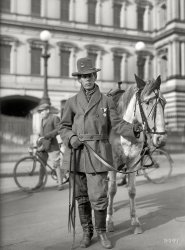
- Welcome to Florida: 1936
- ... St. Johns County, Florida, circa 1936. "Fountain of Youth, Indian Burial Ground, St. Augustine." Be sure to stop by the gift shop on your ... thing is one of the reasons Congress passed the Native American Graves Protection and Repatriation Act .
Fountain of Youth ... Posted by Dave - 03/25/2013 - 11:01am -
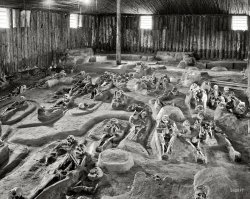
- Ellis Island: 1911
- ... Charlotte Edith Anderson was the first Canadian Indian to be trained as a nurse, though no hospital in Canada would train her. ... home, and told them to use his new name, now that he was American. Or they Americanized them soon after arrival, to blend in. Or a ... Posted by Dave - 08/01/2012 - 5:43pm -
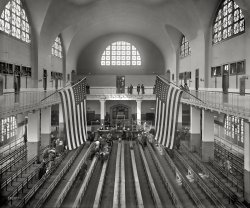
- Isham Jones Orchestra: 1922
- ... Chief John Kuhn, the tubist here on sousaphone, claimed American Indian heritage and was known as "The Chief." He had a special mouthpiece made ... Posted by Dave - 08/01/2012 - 5:37pm -
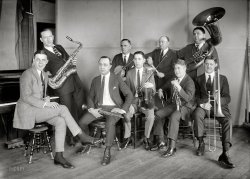
- Ninth Street: 1915
- ... Google images research and can't identify it. Early American cars were produced in RHD. Ford switched to left hand drive production ... D. Dean, proprietor
Howard A French, 424 9th St - Indian Motorcycles
Christiani Drug Store, 426 9th St
Friedlander Bros, ... Posted by Dave - 07/17/2012 - 10:18pm -
![Ninth Street: 1915 Washington, D.C., 1915. "Street scene, Ninth Street N.W." Among the merchants represented here is department-store magnate Julius Lansburgh. View full size.
Devil in the detailsAnother great Shorpy photo, teeming with robust urbanites, no doubt in early spring. Look at those women. New York's Fifth Avenue had nothing on them! This photo depicts the plethora of transportation modes available in cities in those days. We need to take a cue for our own times, though bringing back the horse could be problematic.
Fixed gear bikesNotice that none of the bikes left leaning against the curb have locks. Imagine trying that today.
AdvertisingI love the painted-on-brick ads. You only see faded ones nowadays - I wonder why they went out of fashion? Maybe they needed touching up too often.
I'm intrigued by the "Backward Season" sign at the importers' on the far left. Was Backward Season a widely-used term for something, or just their own little promotion name à la "Dollar Days?"
["Backward season" was, to judge from the clothing ads in the Washington Post archives, a term used in retailing to describe unseasonable weather in both spring and fall. It was certainly the occasion for a lot of sales. Its last use came in 1955. - Dave]
The CarIt would be interesting to know the make and year of the car on the left of the photo...it appears to be a right-hand drive. I've done some superficial Google images research and can't identify it. Early American cars were produced in RHD. Ford switched to left hand drive production in 1906 and Cadillac in 1916. What a great image....thanks Shorpy!!
Horse anchorWhat is that cone-like thing on the ground with a rope or something leading up to the horse. Is that some sort of anchor to make the horse stay put while the driver's inside? Kind of like the anchor of a boat? If not, the question still stands. What is that thing?
I actually think...This is Ninth Street NW looking north. Just beyond the Lansburgh that's the old Riggs Bank building at the southwest corner of Ninth & F.
[You are correct! I have changed the caption accordingly. - Dave]
Wow, what detail!Horse drawn (no overhead wires) trolley tracks. [The trolleys were electric. See above. - Dave]
Packages at far right perhaps reels of film? (in front of Washington Film Exchange). 1915 was the year of "Birth of a Nation" so who knows?
Sign for Smyrna rugs is seen 7 years in advance of the burning and slaughter of many citizens of Smyrna, now known as Izmir.
One of the best.
Horse TetherThat "anchor thing" on a leather strap was a steel weight to temporarily tether the horse, used on milk and bread wagons as well.
Hitching weightThe triangular thing on the ground under the horse is probably a hitching weight, somewhat like this. Just heavy enough that the horse thinks it's tied up, but light enough to transport.
Not horse drawn street carsThe street cars in downtown D.C. ran from an underground feed (see the slit midway between the rails). As you moved away from the downtown area they raised the trolley pole and switched to the overhead wires.
Washington Trolleyswere electric by 1915. What looks like a third rail on the tracks is a slot, in which the power line was buried. The trolley cars had a pickup on a "plow" that projected down into the slot and made contact. That system stayed in use until trolley service was discontinued in the early 1960s.
Actually trolley power came from underneathTexcritic, the tracks aren't for horsecars. The Washington system was a cable car system with a continuously moving cable underground which each car would engage in order to move. See the "center rail" between the tracks? The gap in that center rail allowed the cars to grab the cable and move.
[Not quite. The streetcars here were electric. Although there was a traction line in Georgetown. - Dave]
Ninth St NWDave, I think this is 400 block of Ninth Street NW looking north. A few of the businesses I have verified are:
Dean Hats, 422 9th St - Benjamin D. Dean, proprietor
Howard A French, 424 9th St - Indian Motorcycles
Christiani Drug Store, 426 9th St
Friedlander Bros, 428 9th St - Men's Suits
S.S. Shedd & Bros, 432 9th St
Plaza Theater, 434 9th St
Offterdinger Cigars, 504 9th st - Henry T. Offterdinger, proprietor
On the right side of the street are Crandall's and Moore's Garden Theaters - seen in this Shorpy photo.
Kodak momentI note on the left of the image a sign offering Kodak film and developing. Makes me think that someone from that business stepped out across the street to make an impromptu photo. What is amazing is that for the slow speed of the films (low sensitivity to light) in those days that they were able to get the motion of the pedestrians almost unblurred. It must have been a very sunny day to get away with a faster shutter speed to freeze the action.
[This photograph was made on glass, not film. - Dave]
Hair splittingI think this is 9th street looking south, taken from the immediate left of the old Riggs building. It's going downhill sharply, and I remember the Gaiety theater being a few doors down from Riggs on the right when looking south.
Those buildings on the left house the Spy Museum.
[This is looking north, not south -- even-numbered addresses are on the left. The Spy Museum is on F Street. The buildings on the left have all been replaced by the J. Edgar Hoover Building. - Dave]
Not Ninth StreetThe photo is of Seventh Street, NW. Look at the top center for the Lansburgh Dept Store signage.
[This is indeed Ninth Street. You're confusing the Lansburgh department store with the Lansburgh furniture store. - Dave]
+95Below is the same view from December of 2010.
Early FordThe forged front axle is the identifying feature. It is a Ford prior to the Model T. I'm leaning toward a 1911 Touring Car. The very basic design is reflected in Henry's Model B of 1905. That would be about the sixth Ford model produced.
(The Gallery, Cars, Trucks, Buses, D.C., Harris + Ewing, Stores & Markets)](https://www.shorpy.com/files/images/04626a.thumbnail.jpg)
- Our Little Pony: 1938
- Washington, D.C., circa 1938. "Native American boys with bicycle." The original caption for this photo, which has been lost, probably did not use the phrase "Native American." Harris & Ewing Collection glass negative. View full size.
... little, eight little, nine little Indians
Ten little Indian boys.
Ten little, nine little, eight little Indians
Seven little, ... Posted by Dave - 10/27/2019 - 3:21pm -
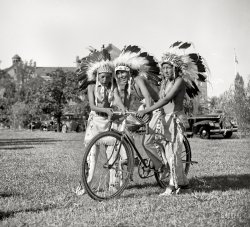
- Daughters of Pocahontas: 1927
- ... Calling Eulalie Mackecknie Shinn This reminds me of the Indian scene in "The Music Man" where the Wa Tan Ye girls perfom in River City! ...
Such Seriousness! All of the handmade Native American leather reproduction clothing would fetch a fortune now days. ... Posted by Dave - 01/04/2013 - 2:15pm -
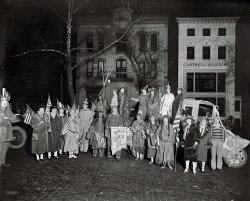
- The Whiteboard Jungle: 1957
- ... several men of colour in the photo.
There were many Indian, especially Parsi, electrical and computer engineers working at IBM and ... is now considered one of the masters of mid-20th century American architecture. He designed campuses for several large corporations. His ... Posted by Dave - 11/03/2013 - 12:41pm -
![The Whiteboard Jungle: 1957 Circa 1957. "IBM Manufacturing and Administrative Center, Rochester, Minnesota. Cafeteria. Eero Saarinen, architect." Medium format negative by Balthazar Korab. View full size.
Fire ExtinguishersApparently, only tall people are supposed to fight fires.
Where's Waldo?All white males.
[Except for the women. -tterrace]
A sea of white shirtsMy uncle worked for IBM in the early 60's in NYC. He had a wardrobe full of white shirts as that was all they were permitted to wear if they dealt with the public. I'm thinking the striped shirt and plaid shirt guys were visitors or only worked internally?
Industrial ModFirst of all, I don't see anything that would burn in that cold, anuglar room. It's about as unwelcoming as a place could be what with its "I" beams everywhere, bland light fixtures and the plants, if they are real, don't even provide any relief. A perfect set right out of "The Organization Man" or "The Man in the Gray Flannel Suit" and I'm sure Atlas would have shrugged in this year of his birth.
Smoke 'em if you got em.Ashtrays on every table, fire extinguisher on every pole.
37 years an IBM-erMy dad was a field engineer for IBM from 1952 to 1987. Into the 1970s, he would come home from work with grease on his white shirts from fixing computers and printers. I got to play "office lady" with discarded punch cards, and he still has a box of old paper from a daisy-wheel printer that he doesn't want to throw away!
Sign of the timesThat picture reminds me so much of my high school cafeteria, which was built in 1956-57. If that building is still standing, I wonder how many of those windows remain. Most other buildings I've seen have replaced most of their windows with solid walls.
CuttingsThe ubiquitous cut-leaf philodendron of the 1950s and early 1960s are rarely seen in homes or businesses. Then it was the most popular indoor plant. It was very attractive, practically kill-proof, didn't leave dead leaves all over and was relatively easy to trim or let go wild, depending on your taste. We had one from about 1958 until the mid-1970s that survived three moves and a fair bit if neglect and/or overwatering. It finally died after one of our cats took to "watering" it himself.
Parsi engineersIt is likely that there are several men of colour in the photo.
There were many Indian, especially Parsi, electrical and computer engineers working at IBM and other major companies. Students from India were studying engineering and in other technical fields at MIT as early as the late 1800s. Historian Ross Bassett of North Carolina State University has been documenting the history of Indian engineers who studied at MIT and the Indian Institute of Technology and who became engineers at IBM and other companies.
He is working on a bio of my step-father, Soli Dubash, (amongst others) who studied engineering at MIT before and after WWII and went on to work on many prominent architectural projects across Canada, achieving the position of Chief Engineer at the Department of Public Works, here in Ottawa.
http://history.ncsu.edu/faculty/view/ross_bassett
http://www.youtube.com/watch?v=Qht2ReRubP0&list=PL7F39BE4A3867E47F&index...
I've been working here for thirty yearsIn answer to previous comments...
The floor to ceiling windows in this photo were just replaced this summer (2014) with a new set of energy efficient windows. Still floor to ceiling.
Fire extinguishers are gone. "Best practice" now in case of fire is to exit the building and leaving the fire fighting to the pros.
Ashtrays are gone. The site has been smoke free for many years now. People still dumb enough to smoke have to stand out by the parking lot in the 20-degree below zero winters.
Mentioned in the photo caption, Eero Saarinen is now considered one of the masters of mid-20th century American architecture. He designed campuses for several large corporations. His most famous work was probably the "Gateway Arch" in St. Louis.
The IBM campus in Rochester, MN shown here is a grid of many low buildings (at most two stories above ground level). It was IBM's first US facility built outside of the Northeast US. With more square footage than the Empire State Building and roughly half the size of the Pentagon, this facility has, for decades, been IBM's largest facility under one roof.
(The Gallery, Balthazar Korab, Eateries & Bars, The Office)](https://www.shorpy.com/files/images/SHORPY_00522u.thumbnail.jpg)
- Little Rascals: 1923
- ... One kid with glasses. One non white fellow, perhaps American Indian?
And such diverse expressions as well!
That's my dog! ... Posted by Dave - 11/23/2011 - 3:58am -
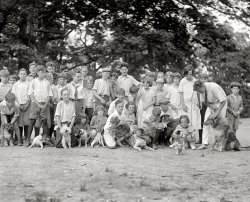
- Artist and Model: 1926
- ... more representative of "Dutch Boy Paints" than a Native American!
Did the sculptor start off with lots-o-clay to simulate the ... little white boy, and then scrape it down to lean/mean Indian physique??
Clear the cache! Clear the cache! Between this and the ... Posted by Dave - 10/27/2019 - 3:29pm -
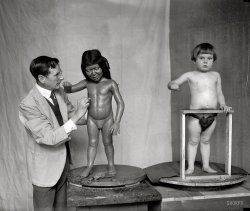
- Lake Worth: 1908
- ... For example: it's the Halifax River in Daytona Beach; Indian River down near Cape Canaveral; and eventually Biscayne Bay in Miami.
... across Lake Worth to West Palm Beach.
The American Scene, 1907,
by Henry James.
It is by means of a light ... Posted by Dave - 08/13/2013 - 3:38pm -
![Lake Worth: 1908 Palm Beach, Florida, circa 1908. "Along the shore of Lake Worth." 8x10 inch dry plate glass negative, Detroit Publishing Company. View full size.
Whew!Having lived in Florida for a spell, I just can't imagine HOW they dealt with the heat having only fans and no A/C. Yet somehow they survived!
[Palm Beach, and Florida in general, was a winter resort. People didn't visit when it was hot. - Dave]
I realize that, I was speaking of life in Florida in general, year-round. It can get to 90 in January :)
ContrastsA straight shoreline and crooked trees.
Geography Palm Beach is a barrier island off the mainland from West Palm Beach. The body of water which separates West Palm Beach and Palm Beach is called Lake Worth; but it is really just part of the Intercoastal Waterway that runs down the length of the coast of Florida from Jacksonville to Miami.
Seems like each segment of the Intercoastal has been given a different name as it runs through different parts of the coast. For example: it's the Halifax River in Daytona Beach; Indian River down near Cape Canaveral; and eventually Biscayne Bay in Miami.
One assume the picture was taken on the grounds of the massive hotel in the background, but it's really hard to say which part of Lake Worth is pictured.
[You are no doubt thinking of the Intracoastal, not "Intercoastal," Waterway. - Dave]
Well, if you Google it, you find that both spelling are used to describe this passageway. I've always heard it called "Intercosstal."
[Google indeed reveals plenty of misspelled words. The waterway in question is the Intracoastal -- meaning along a single coast. Intercoastal would mean connecting two coasts. I was born in Miami and grew up in Florida, and so was well acquainted with the Intracoastal. - Dave]
Adult Perambulators
Farm Journal, November 1905.
No horses are allowed in Palm Beach, — only a lone mule pulling a light summer car along the famous palmetto avenue, from Jake to ocean, … The only other land conveyances are single and double bicycle chairs propelled by liveried colored men at a cost of $1 per hour. These can be seen going in every direction on the paved walks, the jungle trails, and over the long bridge across Lake Worth to West Palm Beach.
The American Scene, 1907,
by Henry James.
It is by means of a light perambulator, of "adult size," but constructed of wicker-work, and pendent from a bicycle propelled by a robust negro, that the jungle is thus visited; the bicycle follows the serpentine track, the secluded ranch is swiftly reached, the peaceful retirement of the cultivators multitudinously admired, the perambulator promptly re-entered, the darky restored to the saddle and his charge again to the hotel.
Waterway NamesThe reason for different names along the Intracoastal Waterway is that the different names were usually there first. The Waterway is a route - like a US Highway route on land, which might run over many roads with different names, but always the same route number. Many parts of the Waterway were originally separate bodies of water that have been linked by man-made canals and channels.
On a different note - why are the trees on the left side of the photo so twisted and the ones on the right side comparatively straighter?
"Intercosstal"As in "between the ribs"?
Landscape architectI think Dr. Seuss must have been in charge of tending the trees on the left side of the walk.
Favorite Bike TrailWhen I lived in WPB I used to ride on the Lake Trail regularly. This is a section of the South Trail with the Flagler mansion in the background.
Palm Beach Lake TrailThe Palm Beach Lake Trail has changed very little in the past 100 years. At the time of the photo the building in the background was the Henry Morrison Flagler home. Today it is the Flagler Museum. The Lake Trail runs some 6 miles almost to the Palm Beach Inlet and is only for pedestrians and bicycles.
(The Gallery, Bicycles, DPC, Florida)](https://www.shorpy.com/files/images/SHORPY_4a23623a.thumbnail.jpg)
- Here Come the Cars: 1940
- ... Definitely a 1939 GMC hauling the load of cars. In 1940 American auto makers went to sealed beam headlights in place of the old bulb ... the local newspaper did. According to the Feb. 15, 1940 Indian Journal (the official publication of the City of Eufaula, Oklahoma), the ... Posted by Dave - 11/10/2012 - 3:46pm -
![Here Come the Cars: 1940 February 1940. "Auto transport passing through Eufaula, Oklahoma." Now playing at the Chief: "Hunchback of Notre Dame." 35mm nitrate negative by Russell Lee for the Farm Security Administration. View full size.
CarspottingAs best as I can tell: That's a load of 1940 Pontiacs being hauled by a circa 1939 GMC. They're passing a parked 1938 Ford Standard. Immediately behind them is a 1940 Dodge. The car behind the Dodge is a 1938 Ford Deluxe or a 1939 Ford Standard (hard to tell at this resolution).
Can any other Shorpyite identify the other vehicles in this picture? If my dad were still alive (WWII Navy vet--happy Veterans Day, Dad!), I'm sure he could.
Product PlacementAmid the traffic, the Coca-Cola sign and the Pontiacs there magically appears a 7-Up delivery truck.
OKNot a quad cab pickup truck visible on an Oklahoma town's main street? How delightful. Town's folk drove what was practical back then.
You like it, it likes youAnd I like the 7-Up delivery truck heading down the street.
Classic vehiclesDefinitely a 1939 GMC hauling the load of cars. In 1940 American auto makers went to sealed beam headlights in place of the old bulb style and GMC had to put the parking lights which had been mounted inside the headlight buckets out on the tops of the fenders.The sedan delivery immediately to the right of the rig looks like it could be a 1933 or 34 Ford and the panel coming out of the side street (with the name TEEL) is a mid 30s Dodge humpback. I love the fender skirts on the 7-Up truck body. Some classic vehicles.
More carsBehind the '38 Ford is a '38 Oldsmobile, and beside it is a '39 Chevy.
Surprised no one has commented on the remnants of a marching band in uniform in the background of a shot (note the Sousaphone!) Wonder what the occasion was.
The Eufaula bandRussell Lee's photographs from that day did include shots of a short parade, in which a marching band was followed by a few gentlemen giving rides to others in wheelbarrows. The notes from the photos in the Library of Congress archives gave no clues of the occasion, but the local newspaper did. According to the Feb. 15, 1940 Indian Journal (the official publication of the City of Eufaula, Oklahoma), the local Jaycees were planning a "Street Comedy Act," including a marching band, as the culmination of competition between two teams to increase the chapter's membership. The "comedy act" would involve having the losing team's members giving wheelbarrow rides to the winning team's members.
How'd they do it?How'd they get the car over the transport cab up there?
[I'm guessing a ramp. - tterrace]
Probable loading sequenceThe car over the truck cab was loaded first, using the ramps to bridge the gap between the top of the rear ramp and the truck cab. The middle car was loaded next and the car in the back was loaded last. It took a lot of shifting of the ramps around. I wonder how many cars were damaged during loading and unloading in those days
One moreI believe there is one more new car inside the trailer underneath the top rear car. It has a cover over it to protect it from debris kicked up by the tires of the truck.
Dad's hangoutMy father was about 8 years old and living in Tulsa when this photo was taken. His Aunt Bea (and other relatives) where of Creek heritage and lived in Eufaula at the time. From time to time, he would get to go to Eufaula and visit her for a weekend, or maybe spend a couple of weeks during the summer down there with her. He always spoke fondly of these trips and had a special place in his heart for his aunt. Many of our Creek relatives are buried at the cemetery there near the main highway.
(The Gallery, Cars, Trucks, Buses, Movies, Russell Lee)](https://www.shorpy.com/files/images/SHORPY_8a27939a.thumbnail.jpg)
- The Secret of Scout Camp: 1925
- ... of the Boy Scouts of America. Founded in 1915, it uses American Indian traditions and ceremonies to bestow recognition on Scouts selected by ... Posted by Dave - 07/12/2014 - 3:01pm -
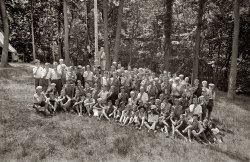
- Knott's Berry Farm 1958
- ... you could get your picture taken with saloon girls or the Indian chief (who would lend you a feathered headress), you could watch the ... (smashed?). Founder Walter Knott was such a lover of American history he built a replica of Independence Hall in the 1970's ... Posted by notycoon22 - 09/22/2011 - 11:29pm -
![Knott's Berry Farm 1958 Was reading an article by Steve Martin the actor/comedian in the New Yorker the other day and he mentioned that he'd started his career in show business at Knott's Berry Farm in the 60s. Wandering through some old family slides and, lo and behold, here's a shot from 1958. Predates Martin a bit, but I'm guessing it looked pretty similar. Oh, and that's my family on the right.
Photographer: Don Hall Sr.
Don Hall
Yreka, CA
View full size.
Thanks for posting thisAs a wee lad in the 1963-65 timeframe I went to both Knott's Berry Farm and Disneyland. Mouseville was much more entertaining, and all the photos and film clips set at Disneyland have reinforced my memories of that place.
But . . . why so little media attention to the Berry Farm? About all I remember of visiting there was learning they made jams and jellies.
Looks like a place I'd enjoy a lot more as an adult.
Knott's Berry FarmSadly, I can't remember Knott's Berry Farm, but I know I went to it and Disneyland when I was about 2-3 when we lived in Redondo Beach, Ca. in the early to mid 60's. But my mom loved it and often talked about it.
In GOD I trust, JOY
Knott's Berry FarmIn the 1960's the hippies started hanging out and sleeping in the trees and such. Fences were put up and then admission became the way of things. Before that the place was wide open. Some of the employees refer to those days as BH, for before hippies. I grew up near there and most folks in the area had very fond memories of the place. It is owned by big business now and just not the same.
Walter Knott's PlaceI went there during the 40's and 50's, when I lived in Manhattan Beach. There was no central admission point, you simply wandered from building to building. I believe the owners also owned Calico, a "ghost town" out in the desert.
Steven
Knotts Berry FarmI worked at Knotts on and off from 1956 thru 1960. It was all open when I worked there, but we had to move because my daughter, who was 2 years old, was allergic to the smog, and the doctors said she could lose her eyesight if we stayed there. I believe the fences went up and admission charged in the late 60's, because you could have picnics anywhere on the grounds, but no alcohol was allowed on the place when I worked there. People started drinking, leaving beer bottles on the lawns in the picnic areas, and abusing the Knotts family generosity. The Knott family treated their employees as family. I loved working there.. My whole family worked there. My dad Ed Kingsley was foreman of the stage line, my brother Eddie drove covered wagon, my mom Sibyl and sister Rita ran the burro ride. My brothers Dick and Treat robbed the stagecoach and covered wagons.
What fun memories, summers, by the time we got off work it was usually about 11 PM... Often all the cowboys from the stage line, the Indians and the girls from the Grill would head for Huntington Beach and build a big bonfire, roast hot dogs and marshmallows and body surf by moonlight. What wonderful memories I have of those days.. Or all of us heading to Pasadena for the Rose Bowl parade. Dad and his boss Bill Higdon driving stage, all heading to my aunt's afterward for waffles. I remember Bill Hidgon had long white hair and beard and always wore a red long sleeved shirt. My little cousins thought he was Santa Claus. I would love to step back in those times once more.
50 Years of visiting Knott'sMy family moved to the area in 1958. We started visiting KBF on a regular basis. It was all free then and we enjoyed walking around the ghost town. My brother & I usually ended up chasing the chickens around in the parking lot. Years later I "donated" two roosters, Charlie & Oscar, to their collection as we couldn't keep them at home anymore. A girlfriend's father, Russ Wildey, was one of the piano players in the old saloon in the early & mid 60's. I had an older female cousin who was dating one of the train robbers at that time. KBF was a lot of fun for us kids then. Actually I liked it a lot more before they fenced it in, but understand why it was necessary. I now take my grandkids there and love seeing them having their own fun.
Knott's Berry FarmIn the 1960s I would visit almost every day to listen to the Wagon Masters, the beginning of my love affair with folk music. I have been looking for their records (LP'S or any format). To my surprise on one of my visits back to KBF, the present employees of the park do not know The Wagon Masters.
[You should look on eBay. The group's name is the Wagonmasters -- one word. Currently there are eight Wagonmasters albums for sale. Click here. - Dave]
Married to a Wagonmaster!Hey email me...I'm married to Harvey Walker, back row, far right. I can tell you where you can get all the albums, now in CD form. Thanks for remembering them. Rachel has passed away, as well as Bobby (back row, far left. KC@KCDOUGLAS.COM
Train robbers.My sister and I went on a road trip with our grandmother and her sister from S.F. Bay Area down to see Disneyland around 1958. That was one long trip in those days. Disneyland was great of course, but I really liked Knott's Berry Farm. I was 5 years old, and cowboys were a big deal for kids my age. It really felt like I was back in the frontier days.
So we decide to take the train ride, and everything was really neat. The all of a sudden, these two guys in masks kick in the door to the train car we were on and shoot off their guns and yell out that this is a robbery.
Well nobody told me that these guys weren't actual train robbers, and I was scared out of my mind. All could think off was, "Please don't kill my Nana." The panning for gold was also a big hit with me. I'm pretty sure I still have the little tube with gold in it stashed somewhere.
Russ Wildey, my dad.Russ also played piano at Disneyland, Shakeys, and the Gaslite Lounge in the 1950s & 60s. Born in 1900, he was most famous in the 1920s. He and his partner Bill Sheehan were known as the Ray-O-Vac Twins. They worked for RKO Radio making appearances across the country and playing live broadcasts. Bill sang while Dad played the piano. Their sheet music is still sold online. It's fun to see his picture on the covers, looking so young. Dad passed away in 1964, I was 13.
The Good Old DaysIn 1968 the fence went up around Knotts Berry Farm. I remember because I was ten but my best times there were when it was still an open park. It had been an open park dating back to when it was not much more than a berry farm and berry stand on the side of the road in the 1920's. They served boysenberry pie, that was the only berries they grew or sold. No one else grew or sold boysenberries so it was quite unique and soon the crowds came. By my time it had already grown into a successful theme park many years earlier. But I do remember the days in the 1960's when Steve Martin not only played at the Bird Cage Theater but would walk to the stunt man show and do their crowd warm-up. He would joke around while people came in to find seats in the covered wagons that surrounded the stage and then joke around a little with the stunt men at the beginning of the show. He wore a giant funny cowboy hat, like they do at football games now, and I remember him being the funniest guy I've ever seen. So I've literally been a fan of Mr. Martin from the beginning.
As far as Knotts Berry Farm goes, there were nice tree covered parking lawns on three sides and you could enter the park from all sides. The front entrance was the most popular because that's where the restaurants and shops were (and still are). They also used to have a San Francisco style cable car (on a track) that ran to the front parking area and dropped you off right in the center of the park between the train depot and stage depot. You bought attraction tickets at various ticket booths just like you would at a neighborhood carnival and they were just a little smaller than a DO NOT DISTURB sign for a hotel, like train tickets, so the ride operator could punch it and it became a souvenir. They were used for the train, stage, calico coal mine ride, haunted shack, mule ride, and various old-style amusement park rides.
There was also Old MacDonald's Farm with a petting zoo and a chicken that would play the piano if you dropped a nickel in a slot to release feed on the keys. There was an organ grinder with a monkey who would untie your shoes and take your dime, and a goat that always seemed to be standing on the peak of the barn roof.
Free attractions included lots of historic structures including the original Knotts Berry stand, a real country church with steeple that held the only regular services within an amusement or theme park (also weddings), a small chapel created by a local artist that showed the transformation of Christ via a wall to ceiling stained glass and special effects lighting and music. Lots of little narrated shows like a 3D panorama showing Mrs. Knott's grandmother crossing the desert in a covered wagon and begging for water. It was only six minutes long but after the little girl cried "mommy, can I please have a drink of water" and her mother replying "I'm sorry we have to save it for the horses, try to get some sleep now" there wasn't a dry eye in the house. Models of all the missions in California were depicted in scenes along a covered walkway, I doubt any kid would stop to look at those today. There were shootouts to watch and you could get your picture taken with saloon girls or the Indian chief (who would lend you a feathered headress), you could watch the blacksmith make a horseshoe, pan for gold (you would get to keep the gold dust in a little bottle), watch a corpse rise from the undertakers carriage, walk around boot hill, and talk to Sad Eye Joe in his jail cell who despite being just a stuffed dummy, spoke to you and always knew your name and everything else about you (he's been there since 1940 but if your parents aren't there talking to his partner around the corner he might not remember your name). Some of that still exists, but basically its just Knotts in name only, quite a different park exists there now and much of what I described torn down or slated to be torn down.
The jellies are now owned by Smuckers and the park by Cedar Fair who's opinion is if its not a fast ride, bulldoze it down, historical who cares. The old church which looks like a Thomas Kinkade painting is being destroyed because they don't want the expense to move it. The old chapel was torn down and the artwork (smashed?). Founder Walter Knott was such a lover of American history he built a replica of Independence Hall in the 1970's including the Liberty Bell and a tour that recreates the signing of the Declaration of Independence. Cedar Fair decided to keep it because it was so accurate Hollywood uses it for movies (National Treasure, for example) and it pays for itself that way.
I remember learning a lot about history at Knotts Berry Farm and what it was like to live a hundred years in the past. I learned it was all about the various people who were each distinct characters in the town. Now its just about indistinct roller coasters with indistinct roller coaster operators and indistinct roller coaster riders having indistinct roller coaster experiences that will last as long as it takes to run to the next roller coaster.
Old Church ChapelMy mother worked in the Chicken House around 1959-1960. I remember as a little girl going to a little Church Chapel with big doors that opened and you would go in and sit down and see and hear a story about Jesus. Does anyone know if that little church is still there? I also remember feeding the seals after Momma got off work.
(ShorpyBlog, Member Gallery)](https://www.shorpy.com/files/images/KnottsBerryFarm1958mr.thumbnail.jpg)
- West Market Street: 1907
- ... the Union (1861-65), the War with Mexico (1846-48), the Indian and British Wars (1811-12), the War of the Revolution and the capture of ... I'm glad there's a Hotel English for me to stay at as my American ain't too flash.
That's the most frogs I've ever seen on ... Posted by Dave - 08/21/2012 - 11:19am -
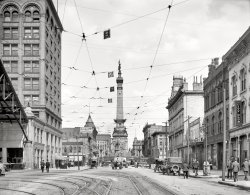
- Dr. Vedder: 1894
- ... His first cousin, Elihu Vedder, Jr., was the renowned American painter. Dr. Vedder eventually sold his museum to the St. Augustine ... during the 1770s British period. They were the licensed Indian traders at the time of the Revolution. It is currently the site of the ... Posted by Dave - 08/20/2012 - 10:22am -
![Dr. Vedder: 1894 St. Augustine, Florida, circa 1894. "Treasury Street." Dry plate glass negative by William Henry Jackson, Detroit Publishing Co. View full size.
Treasury StreetDoesn't the sign underneath the "Dr." say Bay Street - or is that alleyway Bay?
[The "alleyway" is Treasury Street -- the subject of the photo. - Dave]
Wilson's PrideOne of the great picket fences ever! Wonderful!
Great marketingGotta love that sign. Dr. Vedder will make you better.
Augustine, here I comeHave seen now several pictures of Augustine. I believe I should have been born there and not in in the wet-feet country Holland.
Clean alleyObviously, the posts at each end kept vehicles (horse-drawn at that time) from traveling down the alley. No back door deliveries on this segment of Treasury St. Also no horse manure on the cobblestones. If men didn't pee there (forgive me, I have lived in a third-world country), it was not a bad-smelling place.
The alley has a slight V-shape, so water drained to the center and may have flowed ... somewhere. A finger of the ocean was a very short distance away, if today's Treasury Street is still in its 1890s location.
Clean alleys are coming back in style. They are an important pedestrian-friendly component of "New Urbanism" neighborhoods. Other elements of New Urbanism include front porches, neighborhood stores, sidewalks, parks, common areas, and smaller lots -- much like an average middle-class 1890s neighborhood.
Dens of AlligatorsDr. John J. Vedder (1819-1899), seen here, was a wealthy retired dentist and business investor from Schenectady, New York, with a passion for the natural history and fauna of Florida. He transformed his residence into a private museum, Vedder's Genuine Curiosity Store, to house his displays of Florida's native species, and learned taxidermy to create his displays. His first cousin, Elihu Vedder, Jr., was the renowned American painter. Dr. Vedder eventually sold his museum to the St. Augustine Historical Society, its first home. Here is an 1886 advertisement for Dr. Vedder's museum.
AmazingThis is, by far, the most amazing photo I've seen on Shorpy yet. It has a time-machine quality to it; you can almost feel what it would have been like to stand there with the good doctor. The image also has a sense of movement - when you look at the gentleman in the distance at the other end of the alley, who is strolling down the street. I'm left wondering, though, what the sign leaning against Dr. Vedder's 1st floor window says.
["Oceanic Sun Fish." - Dave]
LoveThis is the kind of photo I get lost in. Wonderful. I love you Shorpy's.
Family member hereI am a great-great-great grandson of Dr. John Vedder. I have seen several photos of him but this is by far the clearest. There is a similar photograph in the Rollins College Archives. You can read all you care to know about the Vedder Museum here:
http://freepages.family.rootsweb.ancestry.com/~wabnoles/veddermuseum.htm...
Curlicues and flourishesIt's always fascinating to see how commercial signage styles change. One thing you would never expect to see any more is the decorative detail in the D, and that thingy dangling from the V.
A Great TownAn amazing photograph with the kind of clarity that glass plate negatives could give. Dr. Vedders' building was originally the Panton and Lesley office, built during the 1770s British period. They were the licensed Indian traders at the time of the Revolution. It is currently the site of the Hilton hotel, but the short wall in front is still there, retained as an historical artifact, as is Treasury Street itself, touted for years as the country's narrowest thouroughfare. Bay Street is now Castillo Drive, but is still commonly called the Bayfront. It's a great place to visit!
(The Gallery, DPC, Florida, W.H. Jackson)](https://www.shorpy.com/files/images/4a03634a.thumbnail.jpg)
- Disc Digger: 1956
- ... Africa, 78's were still being made and sold with popular American music as late as 1970. Elvis' "It's Now Or Never", Ray Charles' "Ruby' ... You" and about half a dozen titles by The Beatles on Indian Parlophone are among the extremely late 78's I've personally come ... Posted by Dave - 05/06/2019 - 3:57pm -
![Disc Digger: 1956 August 1956. Southampton, New York. "Teenage girl in record store." Medium format negative from photos for the Look magazine assignment "The Young Have New Ideas: They're the Disc Diggers." Library of Congress Prints & Photographs Collection. View full size.
Torn I'm really flopping back and forth about the young lady seen here. She's lost the sleeve to the recording and has her fingers mucking up the precious grooves. But, she's so awfully lovely that it would be tough to risk making her dislike me for saying anything. Oh well, it seems she's won out, is there more of her?
She's making the vinyl-holics winceAs a kid of the 1950s-60s, it took us time to find out proper record handling techniques. This lovely lady is holding onto the disc much as people did with those earlier & sturdier 78s that had just about vanished by the end of the 1950s. Most folks felt they were being fastidious when the disc found its way back into the proper cardboard album, that paper liner sleeve being used almost as an afterthought. An emerging posse of audiophiles was already busily informing the less cautious of us in the error of our ways.
Six eye Columbia Masterworks LPShe's not buying Elvis, more likely a Broadway Soundtrack or something Classical.
Listen!Is that a listening booth behind the young man behind the girl?
I remember as a young man that the store manager would cut off the listening device after a short time if you were listening to an LP. I think that was so we would not just go there to listen to a whole album.
I don't think listening booths are still available since everything is digital now. But if they are it is most likely at the stores that still sell vinyls
Provincial 78sI once saw some 78 rpm records for sale of songs by the Beatles from 1964. They were made in a province of Canada.
Question about new fontsI'm beginning to get used to the new Large Type Edition of Shorpy, but one thing looks strange. Using Google Chrome 74, on the main page, in the thread titles, the lower case I appears as a lower case L. Is this something that can be fixed? For example, "Fairy Kist" appears as "Falry Klst".
[More pixels will fix your problem. Any newish HD video monitor should do. - Dave]
Guess the AlbumBillboard No. 1 albums of 1956:
March-April: Harry Belafonte
May-July: Elvis Presley
July-August: "My Fair Lady"
Six-eyes and the 78's demiseThat could very well be a Liberace LP in her hand - which might explain why she's holding it well away from herself and the listening booths behind in such a decidedly harmful fashion. If it were three years later, it could've been "Time Out" by the Dave Brubeck Quartet featuring "Take Five" - which case she would've treated it more like a precious family heirloom.
As far as 78's in the United States, for all commercial and widely distributed intents and purposes, they were extinct by the summer of 1960 (some children's record sets were available in 78rpm until 1964-1965). But, in countries and territories like Mexico, Brazil, India, The Philippines, Thailand, Turkey, Portugal and South Africa, 78's were still being made and sold with popular American music as late as 1970. Elvis' "It's Now Or Never", Ray Charles' "Ruby' and "I Can't Stop Loving You" and about half a dozen titles by The Beatles on Indian Parlophone are among the extremely late 78's I've personally come across.
For the label nerdsThat's a Columbia record with the "Six-Eye" label as used from 1956 to 1962:
http://www.cvinyl.com/labelguides/columbia.php
Looks like LookI knew this photo was from Look Magazine before I read the caption. No photographer credit was mentioned, but it looks like the kind of photos Stanley Kubrick did for the magazine. The teenage girl here is absolutely lovely and has a look of grim determination on her face. I wonder what LP she was so desperate to get her hands on?
[The photographer is Jim Abbe. - Dave]
Kids TodayA few years ago, while packing to move to a new house, I came across a few of my grandmother's old 78's from the 1940s and '50s. My young daughter said "look at those giant CDs!" That gave me a good belly laugh. I tried to explain to her how a record player worked, but she wasn't having any of it.
Kids these days and 10 years before "Time Out"Baron, I thank God that, unlike many scores of millennials, your wonderful daughter hasn't started calling them "vinyls" yet.
That said, I thought I'd drop a little something by that may be a bit of an anachronism to most - an actual Dave Brubeck 78 from 1949 pressed on a vinyl/polystyrene mix from my personal stash of 78's. Both label photo as well as a YouTube post of a transfer recording of it by yours truly.
"Laura" by the Dave Brubeck Trio with Cal "Callen" Tjader at the drums from September, 1949:
https://www.youtube.com/watch?v=3sJ1roWLiY8
(The Gallery, LOOK, Music, Stores & Markets)](https://www.shorpy.com/files/images/SHORPY-09820u.thumbnail.jpg)
- Hurricane Slams D.C.: 1933
- ... that stretch of the road, the grade is the reason why the American troops dug in there to prevent the British from marching on ... side of the Anacostia. If it were Baltimore Ave., then the Indian Queen Tavern would be sitting at the right edge of the frame; also, the ... Posted by Dave - 07/04/2014 - 10:24am -
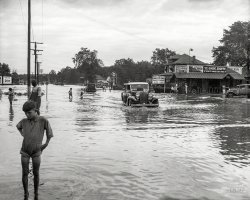
- Hide and Seek: 1919
- ... traders 100 years earlier, who deliberately introduced Indian opium into China to ramp up their trading advantage, and the Qing ... is that (taxed) opium was still a common ingredient in American over-the-counter patent medicines such as cough syrup.
Ways to Hit ... Posted by Dave - 09/12/2011 - 11:18am -
![Hide and Seek: 1919 Circa 1919. "Treasury, Internal Revenue Department; methods of smuggling opium." National Photo Company Collection glass negative. View full size.
Two Hesitant Questions ....1) What are those two, odd-looking, leg-like things on either side in the front?
2 Does anyone here know what the immediate effects of opium are? Why was/is it popular? Are the effects similar to marijuana or crack? Acid or heroin? Something entirely different? Is it a painkiller or merely an hallucinogen - or both?
[The opiates heroin and morphine are rather addictive narcotics. - Dave]
Drug mule's nightmareHarder to swallow than a condom full of cocaine, and just wait until it passes!
Dare to wonderAfter a childhood of weekly D.A.R.E. meetings with "Officer Friendly," I have to say I feel desensitized to this. All I can think is, "well, that's not very concealed" and wonder when smugglers started using car doors and such.
Creepiest Photo YetThis macabre smorgasbord appears to concentrate on ethnic Chinese methods of smuggling opium for the Chinatown markets by disguising the drug as other products. The group includes tea tins, a little medicine bottle with an unreadable (to the U.S. Customs inspectors of 1919) Chinese label, a dried opium poppy, and a variety of "foreign" foodstuffs that most Americans had little curiosity about. The warty little spheres in the lower left are lychee fruit shells refilled with opium paste, and the sinister looking long things in front appear to be dried peppers, also apparently refilled. The pale spheres with short necks are probably Chinese glass single-dose medicinal substance containers that were deliberately mislabeled in a bulk shipment. The bricks of opium paste and the jar in the glove were probably easier to detect. One irony of this photo is that Chinese opium addicts in this country were the long-term victims of European traders 100 years earlier, who deliberately introduced Indian opium into China to ramp up their trading advantage, and the Qing Dynasty government lost two wars, in 1842 and 1860, trying to keep it out. Another is that (taxed) opium was still a common ingredient in American over-the-counter patent medicines such as cough syrup.
Ways to Hit the PipeClifton Sparks gives a late 19th century insight into the D. C. opium trade in a detailed newspaper article (Washington Post, March 8, 1896 p. 14)
As there are different brands of whisky, so there are different brands of opium, and the expert smoker knows them all.
The best brand is known as Li-Yuen. The secret of its manufacture is a closely guarded secret, but it is believed to be a blend of Smyrna and Indian opium. Opium is procured by cutting into the seed vessels of the common white poppy of China, India, and parts of Asia, and collecting the white juice which exudes from the cut. After a few hours this turns black, hardens, and is molded into a lump. It then becomes the ordinary opium of commerce.
The Chinaman takes this and prepares it for smoking by mixing with it a large proportion of water and certain other ingredients, which he prefers to keep a secret. Very frequently it is more or less cooked before it finally gets to this country. It is imported – and smuggled in – in small, square brass canisters, containing from three-quarters of a pound to a pound of the drug. The canisters are never filled owing to the changes which the opium undergoes in travel. If the can were filled the opium would swell and burst the can.
When a Chinaman gets hold of his can of opium he treats it more tenderly than he would his youngest son. It is opened with all due ceremony, and placed in a bowl of warm water to slightly heat it. A sponge wrung out of scalding hot water is placed over the mouth of the can, and a little water is added. By this manipulation the merchant obtains after awhile a semi-liquid black mass of the consistency of thick tar, which is prepared opium. It is then poured into a big, white mug, and vigorously stirred with a stick until is of the same consistency throughout.
Then it is ready either to sell or to smoke. It is a most expensive commodity and to fill the smallest "toi" once, costs a dollar. The raw opium has a peculiar and rather pleasant smell, having the odor of good molasses candy more than anything else.](https://www.shorpy.com/files/images/28560u.thumbnail.jpg)
- Liberty: 1919
- ... foremost float and typified the return of the conquering American heroes in the pursuits of peace.
…
The United States ... headed by Register of the Treasury Teehee, a Cherokee Indian. Miss Jean Goral impersonated Liberty, associated with a group of five ... Posted by Dave - 08/26/2012 - 11:46am -
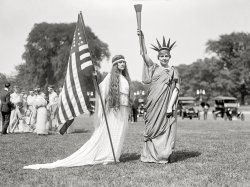
- Tete-a-Tete: 1914
- ... Here's another picture of Frank sculpting an African American child.
Lifecast portrait The extreme lifelike quality of the ... several weeks during the summer of 1912 on the Rosebud Indian reservation in South Dakota looking for models for his marbls busts. ... Posted by Dave - 08/28/2012 - 10:16pm -
![Tete-a-Tete: 1914 Washington, D.C., 1914. "Frank Mischa, sculptor." Co-star in a sort of meta-diorama. Harris & Ewing Collection glass negative. View full size.
Who blinked first?My money is on the sculpture.
Focus -- That's not a staring contest you're ever going to win.
Sculpted from lifeHere's another picture of Frank sculpting an African American child.
Lifecast portraitThe extreme lifelike quality of the skin texture indicates these were almost certainly made by molding directly on the model's skin using plaster or other molding materials. Also the fact that 90 of these finely detailed works were created in short order for an exhibition adds to the likelihood they were cast from life. In lifecasting the front part of the head, including face and neck, are molded, and then the back of the head and hair are recreated, either directly in plaster, or modeled in clay and then the entire composite portrait is molded again and cast in plaster.
Frank Micka, PreparatorThe artist pictured here was also known as Frank Micka. In 1914 he was an assistant to William H. Egberts, the first exhibitions preparator in the physical anthropology department of the National Museum, as the Smithsonian Institution's Natural History Museum was then called.
The exhibitions department created 90 of these plaster portrait busts of tribal peoples from around the world, for Dr. Ales Hrdlicka's physical anthropology exhibit at the 1915 Panama-California Exposition in San Diego. Titled "The Story of Man through the Ages," and displayed in the "Science of Man" exhibit hall, these hyper-lifelike portrait busts were a tremendous popular success, and helped to build support for the founding in 1917 of the San Diego Museum of Man, now an official affiliate of the Smithsonian Institutions.
In the National Museum's annual report for the year ending June 30, 1914, Micka was credited with finishing and painting the sculptures, and also with fabricating their exhibition cases. Despite his obvious skill and sensitivities, he does not seem to have had any other artistic career, and his name appears in none of the usual indexes of American sculptors.
[The Washington Post refers to him as a "New York sculptor," also as a private in the medical corps of the District National Guard. He is also mentioned a few times (as Frank Mischa) in periodicals of the era. He spent several weeks during the summer of 1912 on the Rosebud Indian reservation in South Dakota looking for models for his marbls busts. Micka and an actor friend, according to the Post, bribed a brave "to visit for several days while he made a study of the characteristics of the young Sioux." - Dave]
Master Plaster CasterThis is how Frank would have made this masterful sculpture:
1. He makes an original from clay.
2. He slops a coat of plaster around the clay to create a mold, using metal strips to create two separate halves.
3. The halves are pried off the clay original and rejoined.
4. Plaster is poured or swirled into the empty mold.
5. The mold is once again removed, leaving a plaster replica of the original clay.
(The Gallery, D.C., Harris + Ewing)](https://www.shorpy.com/files/images/04701a.thumbnail.jpg)
- Bowling Green: 1900
- ... foreground. Now the home of the National Museum of the American Indian, and Federal Bankruptcy Court. (And most recently added the National ... Posted by Dave - 12/11/2015 - 11:19am -
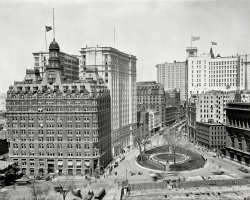
- Bathhouse Row: 1910
- ... excavation, the owners decided to promote the cavity as an Indian cave, and the bathhouse was renamed Quapaw Bathhouse in honor of a local Native American tribe that briefly held the surrounding territory after the Louisiana ... Posted by Dave - 08/15/2012 - 3:07pm -
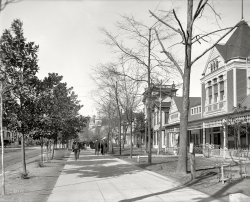
- Me and My Shad: 1920
- ... if serious depletion of some of the most important American fisheries is to be checked. ...
A few years ago shad visited the ... of the resorts along the shores between Washington and Indian Head to offer a round trip ticket on their steamers with a "whole ... Posted by Dave - 09/13/2011 - 1:33pm -
![Me and My Shad: 1920 Circa 1920. "Shad fishing on the Potomac." National Photo Co. View full size.
"Gluttonous Springtime Blowouts"Here's a quote about shad bakes from catfish1.com
During the shad's Hudson River heyday, virtually every river town could boast at least one big annual shad bake—the Hudson's equivalent of the New England shore dinner. New Yorker essayist Joseph Mitchell, in his 1959 piece "The Rivermen," calls these bakes "gluttonous springtime blowouts" and remembered when huge bakes were given by churches, lodges, labor unions, and local politicians.
"The Rivermen" was a long essay for the New Yorker. It was later collected in Mitchell's "The Bottom of the Harbor," which itself was later collected in the masterpiece "Up in the Old Hotel."
Joseph Mitchell was from a small town in North Carolina; after graduating from college, he moved to New York, where he reported for several newspapers and eventually began writing for the The New Yorker in 1933. He worked there until his death in 1991, although he effectively stopped writing in 1964. Shorpyites who are fascinated by the old urban photos, especially of New York City, would likely be fascinated by Mitchell's writing.
Bad shadI've always thought of shad as a trash fish. Were they considered more desirable in 1920 or is there something I don't know about them?
[Planked shad was practically a religion in this part of the country. And shad roe is considered a delicacy by many. - Dave]
Blind to their Own InterestsShad were once plentiful in the Potomac, Delaware and Hudson rivers. Overfishing and pollution were greatly reducing their numbers at the time of this photo. Due to efforts to stock the river with fry and roe, the population in the Potomac lasted a few years longer then those in the Delaware and Hudson. There is now an ongoing project to restore shad to the river.
On a culinary note, in addition to planked shad for dinner, newspapers of the time mention bacon-garnished shad roe as a popular breakfast treat. Of course making a delicacy of the thousands of eggs in each fish no doubt hastened their decline.
Additionally, please don't interpret the title of this post (Blind to their Own Interests, extracted from one of the following newspaper articles) as a condemnation of the hard-working fishermen of the time. Overfishing, as in many exploitations of shared resources, is due to the larger dilemma of the Tragedy of the Commons.
Washington Post, Dec 20, 1915
Driving Out Potomac Shad
Fish Will be Gone Says Commission,
if Greedy Catch Isn't Stopped
Unless protective measures are taken at once by the State of Maryland and Virginia there is a danger that the shad, the most valuable of the migratory river fishes of the Atlantic seaboard, will become unknown in Chesapeake Bay and the Potomac River.
A real note of alarm in this respect was sounded in the annual report of the government bureau of fisheries, which was issued yesterday. Not only is it indicated that the fisheries laws of Maryland and Virginia should be amended, but the laws of all the Atlantic coast States as well.
"The bureau repeatedly has pointed out the shortsighted and destructive course pursued by some of the States with reference to this most important fish," the report said. "The most serious condition exists in the Chesapeake basin, where in 1915, the fishing was the poorest ever known, following a season that was the poorest in a generation. No limits are placed on the operations of the fishermen, who seem blind to their own interests. Every stream which the shad can try to ascend is literally choked with nets.
Washington Post, Nov 27, 1925
Fish Disappearing
Commissioner O'Malley, of the Bureau of Fisheries declares in his annual report that the country is at last awakening to the need of conservation if serious depletion of some of the most important American fisheries is to be checked. ...
A few years ago shad visited the waters of the Potomac in sufficient numbers to enable the proprietors of the resorts along the shores between Washington and Indian Head to offer a round trip ticket on their steamers with a "whole planked shad and a moonlight ride on the return," all for a dollar. In those happy days fishermen offered the choicest "roe shad " at the height of the season for "a levy," and itinerant peddler would bring one to your door, all dressed, for a quarter. Frequently when the fish were "runnin' strong" they were a drug on the market, to be had for carrying them away. Farmers along both shores of the river salted hundreds of barrels of shad and herring every spring, while "Potomac Robins," as the herring were known, were the staple food of most of the colored laboring class.
1914 Advertisement
Washington Post, Jul 22, 1926
Will The Shad Come Back?
...
Thousands of citizens not yet out of the "thirties" can remember when the fish peddler cried his wares through the streets of Washington early in the spring when a roe-shad big enough for a family dinner could be purchased for a "quarter." But there has been a gradual falling off in the catch every year for more than a decade and last May, in the height of the season, the haughty fishmonger scorned the dollar proffered for an insignificant "buck."
The United States fish commissions has carried on restocking operations in the Potomac during the past nine or ten years. This season the number of fry turned into the river at the hatchery opposite Mount Vernon was the smallest in years. There were 10,000,000 fingerlings released from the hatchery. In some years the number has reached 80,000,000 and the commissioner is still hopeful that results will be shown in the returns from the seine haulers.
The falling off in the number of shad caught in Northern waters can only be explained by the growth of cities on the banks of the rivers and the erection of all sorts of manufacturing plants along the shores which have resulted in the pollution of the waters and killed off young fish by the millions. ...
Oh, waiterThe popularity of shad roe is illustrated in the Cole Porter song "Let's Do It" with the line "Why ask if shad do it? Waiter, bring me shad roe."
Fish storyShad fishing in the Hudson River remained a major seasonal activity until well into the 1950's: the rivermen would live on their boats/barges during the shad run. Some time earlier, large sturgeon were plentiful enough on the Lower Delaware that there was a town (Caviar) built around the harvesting of their roe. The Central Railroad of New Jersey had a freight line serving the town.
Not much left of that now.
ShadHere on the Tennessee river, shad are used for cut bait on trot lines. You have to cut up a shad and get the pieces on the hooks as they don't "keep very well" in warm weather.
(The Gallery, Boats & Bridges, D.C., Natl Photo)](https://www.shorpy.com/files/images/18293u.thumbnail.jpg)
- Dr. Springs: 1939
- ... as a medical doctor. He founded the first African-American Boy Scout Troop in the nation. Dr. Springs was awarded the Joseph A. ... sense of humor ... it seems Dr. Springs was African American. Andrew W. Springs was born in 1869 and died in 1944. In addition to ... the community about hygiene, maintained his museum of Indian and other artifacts, even ran for statewide office twice in the ... Posted by Dave - 07/14/2020 - 11:31am -
